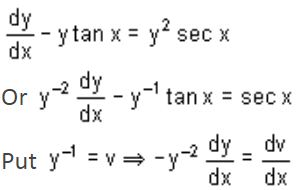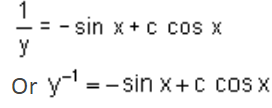Civil Engineering (CE) Exam > Civil Engineering (CE) Questions > The solution of dy/dx – y tan x – y2 sec x =...
Start Learning for Free
The solution of dy/dx – y tan x – y2 sec x = 0 is given by
- a)y–1 = sin x + c cos x
- b)y–1 = – sin x + c cos x
- c)y = cos x + c sin x
- d)y–1 = – cos x + c sin x
Correct answer is option 'B'. Can you explain this answer?
Most Upvoted Answer
The solution of dy/dx – y tan x – y2 sec x = 0 is given bya)y–1 = sin...

Substituting in the given equation, we get


Free Test
FREE
| Start Free Test |
Community Answer
The solution of dy/dx – y tan x – y2 sec x = 0 is given bya)y–1 = sin...
To solve the given differential equation, we can use the method of separating variables.
Separating variables involves isolating the terms with y and x on opposite sides of the equation.
The given differential equation is:
dy/dx - y tan(x) - y^2 sec(x) = 0
To begin, let's rearrange the equation:
dy/dx = y tan(x) + y^2 sec(x)
Now, we can separate the variables by moving all the terms involving y to one side and all the terms involving x to the other side:
dy/(y tan(x) + y^2 sec(x)) = dx
Next, we can integrate both sides of the equation.
Integrating the left side:
∫(1/(y tan(x) + y^2 sec(x))) dy
To simplify the integration, we can factor out y from the denominator:
∫(1/y(tan(x) + y sec(x))) dy
Now, we can use partial fraction decomposition to rewrite the integrand.
1/(y(tan(x) + y sec(x))) = A/y + B/(tan(x) + y sec(x))
Multiplying through by the denominator, we get:
1 = A(tan(x) + y sec(x)) + By
Expanding and equating coefficients, we find:
A = 1
B = -1
So, the integrand becomes:
1/y - 1/(tan(x) + y sec(x))
Now, we can integrate both terms separately:
∫(1/y) dy - ∫(1/(tan(x) + y sec(x))) dy
The integral of 1/y with respect to y is ln|y|.
For the second integral, we can use a substitution:
Let u = tan(x) + y sec(x)
Then, du = sec^2(x) + y sec(x) tan(x) dx
Rearranging, we have:
du - sec^2(x) dx = y sec(x) tan(x) dx
du - sec^2(x) dx = y du
Substituting back into the integral:
- ∫(1/u) du
This becomes -ln|u|.
Therefore, the integral of the second term is -ln|tan(x) + y sec(x)|.
Putting it all together, the integrated equation is:
ln|y| - ln|tan(x) + y sec(x)| = C
where C is the constant of integration.
Now, we can simplify the equation using logarithmic properties:
ln|y/(tan(x) + y sec(x))| = C
Exponentiating both sides:
|y/(tan(x) + y sec(x))| = e^C
Since e^C is a positive constant, we can remove the absolute value signs:
y/(tan(x) + y sec(x)) = e^C
Multiplying both sides by (tan(x) + y sec(x)), we get:
y = e^C (tan(x) + y sec(x))
Expanding, we have:
y = e^C tan(x) + e^C y sec(x)
Now, we can solve for y:
y - e^C y sec(x) = e^C tan(x
Separating variables involves isolating the terms with y and x on opposite sides of the equation.
The given differential equation is:
dy/dx - y tan(x) - y^2 sec(x) = 0
To begin, let's rearrange the equation:
dy/dx = y tan(x) + y^2 sec(x)
Now, we can separate the variables by moving all the terms involving y to one side and all the terms involving x to the other side:
dy/(y tan(x) + y^2 sec(x)) = dx
Next, we can integrate both sides of the equation.
Integrating the left side:
∫(1/(y tan(x) + y^2 sec(x))) dy
To simplify the integration, we can factor out y from the denominator:
∫(1/y(tan(x) + y sec(x))) dy
Now, we can use partial fraction decomposition to rewrite the integrand.
1/(y(tan(x) + y sec(x))) = A/y + B/(tan(x) + y sec(x))
Multiplying through by the denominator, we get:
1 = A(tan(x) + y sec(x)) + By
Expanding and equating coefficients, we find:
A = 1
B = -1
So, the integrand becomes:
1/y - 1/(tan(x) + y sec(x))
Now, we can integrate both terms separately:
∫(1/y) dy - ∫(1/(tan(x) + y sec(x))) dy
The integral of 1/y with respect to y is ln|y|.
For the second integral, we can use a substitution:
Let u = tan(x) + y sec(x)
Then, du = sec^2(x) + y sec(x) tan(x) dx
Rearranging, we have:
du - sec^2(x) dx = y sec(x) tan(x) dx
du - sec^2(x) dx = y du
Substituting back into the integral:
- ∫(1/u) du
This becomes -ln|u|.
Therefore, the integral of the second term is -ln|tan(x) + y sec(x)|.
Putting it all together, the integrated equation is:
ln|y| - ln|tan(x) + y sec(x)| = C
where C is the constant of integration.
Now, we can simplify the equation using logarithmic properties:
ln|y/(tan(x) + y sec(x))| = C
Exponentiating both sides:
|y/(tan(x) + y sec(x))| = e^C
Since e^C is a positive constant, we can remove the absolute value signs:
y/(tan(x) + y sec(x)) = e^C
Multiplying both sides by (tan(x) + y sec(x)), we get:
y = e^C (tan(x) + y sec(x))
Expanding, we have:
y = e^C tan(x) + e^C y sec(x)
Now, we can solve for y:
y - e^C y sec(x) = e^C tan(x

|
Explore Courses for Civil Engineering (CE) exam
|

|
Similar Civil Engineering (CE) Doubts
The solution of dy/dx – y tan x – y2 sec x = 0 is given bya)y–1 = sin x + c cos xb)y–1 = – sin x + c cos xc)y = cos x + c sin xd)y–1 = – cos x + c sin xCorrect answer is option 'B'. Can you explain this answer?
Question Description
The solution of dy/dx – y tan x – y2 sec x = 0 is given bya)y–1 = sin x + c cos xb)y–1 = – sin x + c cos xc)y = cos x + c sin xd)y–1 = – cos x + c sin xCorrect answer is option 'B'. Can you explain this answer? for Civil Engineering (CE) 2025 is part of Civil Engineering (CE) preparation. The Question and answers have been prepared according to the Civil Engineering (CE) exam syllabus. Information about The solution of dy/dx – y tan x – y2 sec x = 0 is given bya)y–1 = sin x + c cos xb)y–1 = – sin x + c cos xc)y = cos x + c sin xd)y–1 = – cos x + c sin xCorrect answer is option 'B'. Can you explain this answer? covers all topics & solutions for Civil Engineering (CE) 2025 Exam. Find important definitions, questions, meanings, examples, exercises and tests below for The solution of dy/dx – y tan x – y2 sec x = 0 is given bya)y–1 = sin x + c cos xb)y–1 = – sin x + c cos xc)y = cos x + c sin xd)y–1 = – cos x + c sin xCorrect answer is option 'B'. Can you explain this answer?.
The solution of dy/dx – y tan x – y2 sec x = 0 is given bya)y–1 = sin x + c cos xb)y–1 = – sin x + c cos xc)y = cos x + c sin xd)y–1 = – cos x + c sin xCorrect answer is option 'B'. Can you explain this answer? for Civil Engineering (CE) 2025 is part of Civil Engineering (CE) preparation. The Question and answers have been prepared according to the Civil Engineering (CE) exam syllabus. Information about The solution of dy/dx – y tan x – y2 sec x = 0 is given bya)y–1 = sin x + c cos xb)y–1 = – sin x + c cos xc)y = cos x + c sin xd)y–1 = – cos x + c sin xCorrect answer is option 'B'. Can you explain this answer? covers all topics & solutions for Civil Engineering (CE) 2025 Exam. Find important definitions, questions, meanings, examples, exercises and tests below for The solution of dy/dx – y tan x – y2 sec x = 0 is given bya)y–1 = sin x + c cos xb)y–1 = – sin x + c cos xc)y = cos x + c sin xd)y–1 = – cos x + c sin xCorrect answer is option 'B'. Can you explain this answer?.
Solutions for The solution of dy/dx – y tan x – y2 sec x = 0 is given bya)y–1 = sin x + c cos xb)y–1 = – sin x + c cos xc)y = cos x + c sin xd)y–1 = – cos x + c sin xCorrect answer is option 'B'. Can you explain this answer? in English & in Hindi are available as part of our courses for Civil Engineering (CE).
Download more important topics, notes, lectures and mock test series for Civil Engineering (CE) Exam by signing up for free.
Here you can find the meaning of The solution of dy/dx – y tan x – y2 sec x = 0 is given bya)y–1 = sin x + c cos xb)y–1 = – sin x + c cos xc)y = cos x + c sin xd)y–1 = – cos x + c sin xCorrect answer is option 'B'. Can you explain this answer? defined & explained in the simplest way possible. Besides giving the explanation of
The solution of dy/dx – y tan x – y2 sec x = 0 is given bya)y–1 = sin x + c cos xb)y–1 = – sin x + c cos xc)y = cos x + c sin xd)y–1 = – cos x + c sin xCorrect answer is option 'B'. Can you explain this answer?, a detailed solution for The solution of dy/dx – y tan x – y2 sec x = 0 is given bya)y–1 = sin x + c cos xb)y–1 = – sin x + c cos xc)y = cos x + c sin xd)y–1 = – cos x + c sin xCorrect answer is option 'B'. Can you explain this answer? has been provided alongside types of The solution of dy/dx – y tan x – y2 sec x = 0 is given bya)y–1 = sin x + c cos xb)y–1 = – sin x + c cos xc)y = cos x + c sin xd)y–1 = – cos x + c sin xCorrect answer is option 'B'. Can you explain this answer? theory, EduRev gives you an
ample number of questions to practice The solution of dy/dx – y tan x – y2 sec x = 0 is given bya)y–1 = sin x + c cos xb)y–1 = – sin x + c cos xc)y = cos x + c sin xd)y–1 = – cos x + c sin xCorrect answer is option 'B'. Can you explain this answer? tests, examples and also practice Civil Engineering (CE) tests.

|
Explore Courses for Civil Engineering (CE) exam
|

|
Signup for Free!
Signup to see your scores go up within 7 days! Learn & Practice with 1000+ FREE Notes, Videos & Tests.


























